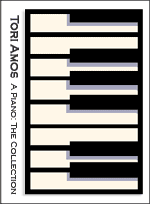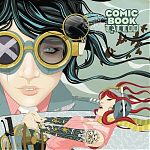- Articles
- Cherries
- Minutiae
- Q&A
- RAINN
- Releases
- Reviews
- Site News
- Them
- Toriphiles
- Touring
- TV/Radio/Web
- Video
News Archives
Keep an eye on our Twitter and Facebook pages since we often post quickie updates there when we're on-the-go.
During tours, we do our best to cover setlists in real-time on Twitter. If you want to tweet a show in, just DM or @ us on the day and tell us to watch your stream that night.
Tori is touring in 2017 to support the release of Native Invader. The European legs runs from early September through early October and the North American leg runs from late October to early December. We do not know if additional dates elsewhere will be added.

Native Invader (album, 2017)

Unrepentant Geraldines (album, 2014)

Gold Dust (album, 2012)

Night of Hunters (album, 2011)

Midwinter Graces (album, 2009)
 Abnormally Attracted To Sin (album, 2009)
Abnormally Attracted To Sin (album, 2009)
Live at Montreux 1991/1992 (DVD, 2008)

American Doll Posse (album, 2007)

A Piano (boxed set, 2006)

Pretty Good Years
(bio, 2006)

Fade To Red
(DVD, 2006)
 Comic Book Tattoo (book, 2008)
Comic Book Tattoo (book, 2008)News: New Yorker Online Concert Review (October 17, 2007)
On the other hand, Sasha Frere-Jones was not as charitable in his review of the second show at Madison Square Garden from his blog on The New Yorker Online (I don’t believe this review is in the print magazine). However, while he may have a point about the costumes and wigs and dolls, it is interesting to compare his thoughts on the concert with his thoughts on the album....
Thanks to char for the link!
Doll Parts
October 17, 2007
So what was it? Why did Tori Amos’s show last Friday night, at the WaMu Theatre at Madison Square Garden, feel like it was suspended in time, lost somewhere between 1992 and 2007? Like an increasing number of her elders and peers, Amos is aging so well that age feels irrelevant to the musical questions. Her voice hasn’t lost any range and her piano playing continues to be good enough to get her back into the conservatory; I still like the playing-two-keyboards-at-once trick.
So I am going to have to call out the costumes and the characters that Amos created for her new album, “American Doll Posse.” The only thing I remember about the characters is that one of them is holding a chicken on the cover. Does anyone but Amos’s most ardent fans know their names?
Amos started the show by appearing as “Santa,” wearing an orange strapless dress and a white bob wig. She entered with a little bit of Fosse flourish, suggesting that Santa is, perhaps, theatrical and irrepressible. But wasn’t plain old Tori those things, too? After a break, Tori returned as “Tori,” which is Amos wearing a big silver jumpsuit and a wig of long, straight red hair with bangs. (This costume caused a woman next to me to text someone, “Is that Ziggy Stardust?”) The encores were performed, I assume, by Tori, and not “Tori.”
Tori spent the nineties channelling multitudes through her songs, acting out revenge fantasies, reliving nightmares, and playing a series of roles that seemed to choose her as much as she chose them: goddess, whore, god, man, woman, cornflake girl, and a host of animals. These characters emerged through song, while she remained Tori, sitting with her legs splayed on the piano bench and letting the heebie-jeebies course through her. Her fan base developed such a strong bond with her not just because of her politics or her empathy for the abused but because when she sang a song she always seemed on the verge of losing herself in it. She was still a person—if more gifted than the person next to you—grappling with something immediate and unstoppable.
The new characters add a level of camp and distance that don’t suit a firestarter like Amos. Her ad-libbed song about cute boys in New York was closer, in theory, to old Tori: she imagined life in the big city as a boy, able to love whomever she wanted. But it was more cutesy than cute. She’s not much of a comedian or a high-stepper—she’s still the one who goes into the cave to slay the dragon. She didn’t need the silver jumpsuit or the wig. Still doesn’t.


